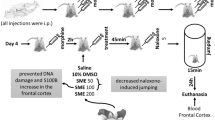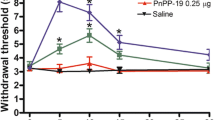Abstract
Objective
Mitragyna speciosa and its extracts are named kratom (dried leaves, extract). It contains several alkaloids and is used in traditional medicine to alleviate musculoskeletal pain, hypertension, coughing, diarrhea, and as an opiate substitute for addicts. Abuse and addiction to kratom is described, and kratom has attracted increasing interest in Western countries. Individual effects of kratom on opioidergic, adrenergic, serotonergic, and dopaminergic receptors are known, but not all of the effects have been explained. Pharmacokinetic and pharmacodynamic data are needed.
Methods
The effects of kratom extract on mice behavior were investigated following oral (po), intraperitoneal (ip), and intracerebroventricular (icv) application. Receptor-binding studies were performed.
Results
In μ opioid receptor knockout mice (−/−) and wild type (+/+) animals, the extract reduced locomotor activity after ip and low po doses in +/+ animals, but not after icv administration. The ip effect was counteracted by 0.3 mg/kg of apomorphine sc, suggesting dopaminergic presynaptic activity. An analgesic effect was only found in −/− mice after icv application. Norbinaltorphimine abolished the analgesic effect, but not the inhibitory effect, on locomotor activity, indicating that the analgesic effect is mediated via κ opioid receptors. Oral doses, which did not diminish locomotor activity, impaired the acquisition of shuttle box avoidance learning. There was no effect on consolidation. Binding studies showed affinity of kratom to μ, δ, and κ opioid receptors and to dopamine D1 receptors.
Conclusions
The results obtained in drug-naïve mice demonstrate weak behavioral effects mediated via μ and κ opioid receptors.









Similar content being viewed by others
References
Ahmad Akhibi MFB (2008) Isolation of major alkaloids from Mitragyna speciosa (Kratom). Faculty of Applied Sciences. University Teknologi, Mara, Malaysia
Ahmad K, Aziz Z (2012) Mitragyna speciosa use in the northern states of Malaysia: a cross-sectional study. J Ethnopharmacol 141:446–450
Apryani E, Hidayat MT, Moklas MA, Fakurazi S, Idayu NF (2010) Effects of mitragynine from Mitragyna speciosa Korth leaves on working memory. J Ethnopharmacol 129:357–360
Assanangkornchai S, Muekthong A, Sam-Angsri N, Pattanasattayawong U (2007) The use of Mitragynine speciosa (“Krathom”), an addictive plant, in Thailand. Subst Use Misuse 42:2145–2157
Becker A, Grecksch G, Brödemann R, Kraus J, Peters B, Schroeder H, Thiemann W, Loh HH, Höllt V (2000) Morphine self-administration in mu-opioid receptor-deficient mice. Naunyn Schmiedebergs Arch Pharmacol 361:584–589
Boyer EW, Babu KM, Adkins JE, McCurdy CR, Halpern JH (2008) Self-treatment of opioid withdrawal using kratom (Mitragynia speciosa Korth). Addiction 103:1048–1050
Hassan Z, Muzaimi M, Navaratnam V, Yusoff NH, Suhaimi FW, Vadivelu R, Vicknasingam BK, Amato D, von Horsten S, Ismail NI, Jayabalan N, Hazim AI, Mansor SM, Muller CP (2013) From kratom to mitragynine and its derivatives: physiological and behavioural effects related to use, abuse, and addiction. Neurosci Biobehav Rev 37:138–151
Horie S, Koyama F, Takayama H, Ishikawa H, Aimi N, Ponglux D, Matsumoto K, Murayama T (2005) Indole alkaloids of a Thai medicinal herb, Mitragyna speciosa, that has opioid agonistic effect in guinea-pig ileum. Planta Med 71:231–236
Loh HH, Liu HC, Cavalli A, Yang W, Chen YF, Wei LN (1998) mu Opioid receptor knockout in mice: effects on ligand-induced analgesia and morphine lethality. Brain Res Mol Brain Res 54:321–326
Matsumoto K, Horie S, Ishikawa H, Takayama H, Aimi N, Ponglux D, Watanabe K (2004) Antinociceptive effect of 7-hydroxymitragynine in mice: discovery of an orally active opioid analgesic from the Thai medicinal herb Mitragyna speciosa. Life Sci 74:2143–2155
Matsumoto K, Mizowaki M, Suchitra T, Murakami Y, Takayama H, Sakai S, Aimi N, Watanabe H (1996a) Central antinociceptive effects of mitragynine in mice: contribution of descending noradrenergic and serotonergic systems. Eur J Pharmacol 317:75–81
Matsumoto K, Mizowaki M, Suchitra T, Takayama H, Sakai S, Aimi N, Watanabe H (1996b) Antinociceptive action of mitragynine in mice: evidence for the involvement of supraspinal opioid receptors. Life Sci 59:1149–1155
Matsumoto K, Mizowaki M, Takayama H, Sakai S, Aimi N, Watanabe H (1997) Suppressive effect of mitragynine on the 5-methoxy-N, N-dimethyltryptamine-induced head-twitch response in mice. Pharmacol Biochem Behav 57:319–323
Matthies H, Schroeder H, Becker A, Loh H, Höllt V, Krug M (2000) Lack of expression of long-term potentiation in the dentate gyrus but not in the CA1 region of the hippocampus of mu-opioid receptor-deficient mice. Neuropharmacology 39:952–960
Matuszewski BK, Constanzer ML, Chavez-Eng CM (2003) Strategies for the assessment of matrix effect in quantitative bioanalytical methods based on HPLC-MS/MS. Anal Chem 75:3019–3030
McWhirter L, Morris S (2010) A case report of inpatient detoxification after kratom (Mitragyna speciosa) dependence. Eur Addict Res 16:229–231
Peters FT, Drummer OH, Musshoff F (2007) Validation of new methods. Forensic Sci Int 165:216–224
Philipp AA, Wissenbach DK, Zoerntlein SW, Klein ON, Kanogsunthornrat J, Maurer HH (2009) Studies on the metabolism of mitragynine, the main alkaloid of the herbal drug kratom, in rat and human urine using liquid chromatography-linear ion trap mass spectrometry. J Mass Spectrom 44:1249–1261
Reanmongkol W, Keawpradub N, Sawangjaroen K (2007) Effects of the extracts from Mitragyna speciosa Korth. leaves on analgesic and behavioral activities in experimental animals. J Sci Technol 29:39–48
Remane D, Meyer MR, Peters FT, Wissenbach DK, Maurer HH (2010) Fast and simple procedure for liquid–liquid extraction of 136 analytes from different drug classes for development of a liquid chromatographic-tandem mass spectrometric quantification method in human blood plasma. Anal Bioanal Chem 397:2303–2314
Sanger DJ (1985) The effects of clozapine on shuttle-box avoidance responding in rats: comparisons with haloperidol and chlordiazepoxide. Pharmacol Biochem Behav 23:231–236
Sanger DJ (1987) The actions of SCH 23390, a D1 receptor antagonist, on operant and avoidance behavior in rats. Pharmacol Biochem Behav 26:509–513
Schröder H, Wu DF, Seifert A, Rankovic M, Schulz S, Höllt V, Koch T (2009) Allosteric modulation of metabotropic glutamate receptor 5 affects phosphorylation, internalization, and desensitization of the micro-opioid receptor. Neuropharmacology 56:768–778
Schröder H, Höllt V, Becker A (2011) Parecoxib and its metabolite valdecoxib directly interact with cannabinoid binding sites in CB1-expressing HEK 293 cells and rat brain tissue. Neurochem Int 58:9–13
Schulz S, Mayer D, Pfeiffer M, Stumm R, Koch T, Höllt V (2004) Morphine induces terminal micro-opioid receptor desensitization by sustained phosphorylation of serine-375. EMBO J 23:3282–3289
Senik MH, Mansor SM, Rammes G, Tharakan JHJ, Abdullah JHB (2013a) Mitragyna speciosa Korth standardized methanol extract induced short-term potentiation of CA1 subfield in rat hippocampal slices. J Med Plants Res 6:1234–1243
Senik MH, Mansor SM, Tharakan JHJ, Abdullah JHB (2013b) Effect of acute administration of Mitragyna speciosa Korth. standardized methanol extract in animal model of learning and memory. J Med Plants Res 6:1007–1014
Shamima AR, Fakurazi S, Hidayat MT, Hairuszah I, Moklas MA, Arulselvan P (2012) Antinociceptive action of isolated mitragynine from Mitragyna speciosa through activation of opioid receptor system. Int J Mol Sci 13:11427–11442
Sheleg SV, Collins GB (2011) A coincidence of addiction to “kratom” and severe primary hypothyroidism. J Addict Med 5:300–301
Shellard EJ (1974) The alkaloids of Mitragyna with special reference to those of Mitragyna speciosa. Korth Bull Narc 26:41–55
Suwanlert S (1975) A study of kratom eaters in Thailand. Bull Narc 27:21–27
Thongpradichote S, Matsumoto K, Tohda M, Takayama H, Aimi N, Sakai S, Watanabe H (1998) Identification of opioid receptor subtypes in antinociceptive actions of supraspinally-administered mitragynine in mice. Life Sci 62:1371–1378
Wang YC, He BH, Chen CC, Huang AC, Yeh YC (2012) Gender differences in the effects of presynaptic and postsynaptic dopamine agonists on latent inhibition in rats. Neurosci Lett 513:114–118
Ward J, Rosenbaum C, Hernon C, McCurdy CR, Boyer EW (2011) Herbal medicines for the management of opioid addiction: safe and effective alternatives to conventional pharmacotherapy? CNS Drugs 25:999–1007
Wille SMR, Peters FB, Di Fazio V, Samyn N (2013) Practical aspects concerning validation and quality control for forensic and clinical bioanalytical quantitative methods. Accredit Qual Assur.2011 279–292
Wissenbach DK, Meyer MR, Remane D, Weber AA, Maurer HH (2011) Development of the first metabolite-based LC-MS(n) urine drug screening procedure-exemplified for antidepressants. Anal Bioanal Chem 400:79–88
Yamamoto LT, Horie S, Takayama H, Aimi N, Sakai S, Yano S, Shan J, Pang PK, Ponglux D, Watanabe K (1999) Opioid receptor agonistic characteristics of mitragynine pseudoindoxyl in comparison with mitragynine derived from Thai medicinal plant Mitragyna speciosa. Gen Pharmacol 33:73–81
Acknowledgments
We gratefully acknowledge the expert assistance of Ms. M. Böx, Ms. P. Dehmel, Ms. D. Heidemann, Ms. G. Borkhardt and Ms. C. Knape.
Conflict of interest
None.
Author information
Authors and Affiliations
Corresponding author
Rights and permissions
About this article
Cite this article
Stolt, AC., Schröder, H., Neurath, H. et al. Behavioral and neurochemical characterization of kratom (Mitragyna speciosa) extract. Psychopharmacology 231, 13–25 (2014). https://doi.org/10.1007/s00213-013-3201-y
Received:
Accepted:
Published:
Issue Date:
DOI: https://doi.org/10.1007/s00213-013-3201-y




